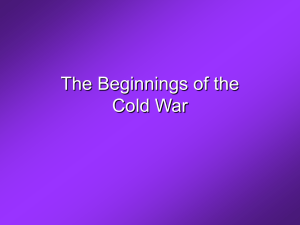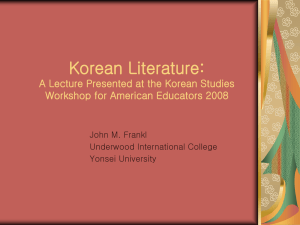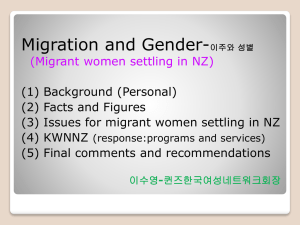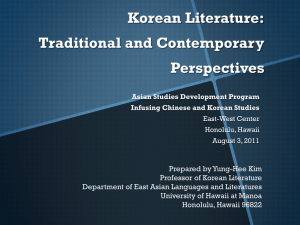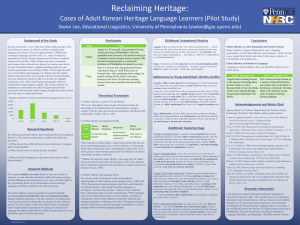Presentation1 - WordPress.com
advertisement
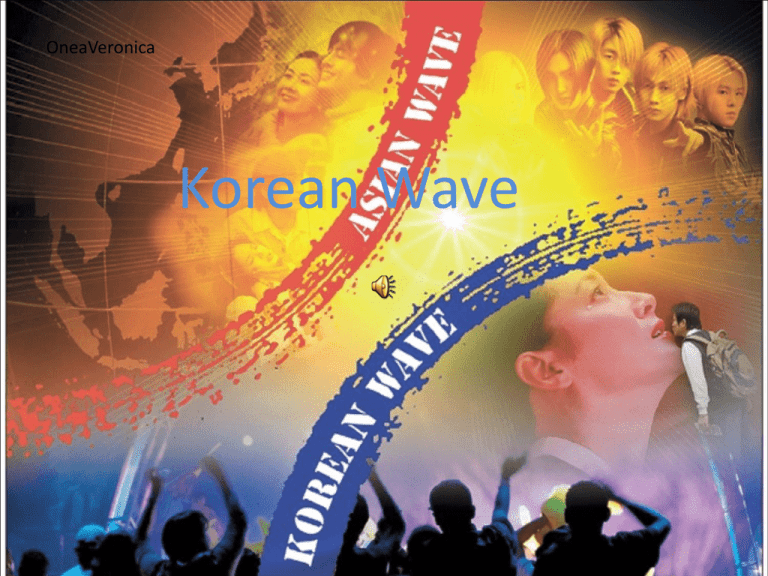
OneaVeronica Korean Wave 1 Explaining the phenomenon • The Korean wave or Korea Fever refers to the significantly increased popularity of South Korea culture around the world since the 21st century, especially among the Net Generation. It is also referred to as Hallyu from the Korean pronunciation. The form was coined in China in mid-1999 by Beijing journalists surprised by the fast popularity of South Korea and South Korean goods in China. 2 • South Korea among the world’s top ten cultural exporters and the Korean Wave began with the export of Korean Tv dramas such as Autumn Tale, Winter Sonata, Dae Jang Geum (which was aired also in Romania),Princess Hours and Boys over flowers across East and Southeast Asia;the growing success of korean dramas was soon matched by movies, popular music ,food and language. I will show some photos of the most loved dramas. 3 Autumn tale starring :Song Seung Hun, Song Hye-kyo and Won Bin 4 Princess Hours Starring: Yoon Eun Hye, Joo Ji Hoon, Kim Jeong Hoon 5 Winter Sonata Starring:Bae Yong Joon, Choi Ji Woo, Park Yong Ha 6 Dae Jang Geum Starring: Lee Young Ae, Ji Jin-Hee, Im Ho 7 Boys Over Flowers Starring:Lee Min Ho, Goo Hye Sun,Kim Hyung Joong 8 Coffee Prince Starring:Yoon Eun Hye, Gong Yoo 9 Birth of the industry • The Korean wave first began in the early 1990s with the film industry under the strict surveillance of the Korean government . Producers were only allowed to screen films approved by certain regulations . Due to censorship and restrictions, producers were limited as to what they were able to produce, giving birth to the melodrama. Such melodramas are now ubiquitous, and are commonly viewed not only in South Korea, but in much of Asia as well. 10 Globalization • The Korean wave is seen as a product of globalization and rise of capitalism in Asia .Advent of giant transnational media corporations in the 1990s lead to development of media technology and simultaneous circulation of media images and texts on a global level. This process prepared a system for the manufacture and circulation of popular culture within Asia. This made circulation of South Korean popular culture in Asia possible, and driven by the appeal of upscale hyper-modern lifestyles that South Korean popular culture provided, the Korean Wave spread among the rising middle-class in Asia and beyond. The success of South Korean dramas, movies, and music served as a major tourist magnet for South Korea in 2005, with tourists from countries such as Japan, China, the Philippines, Thailand, Singapore, Malaysia, Indonesia and Vietnam. 11 K-Pop • K-pop is an abbreviation for Korean Pop, specifically from South Korea. Many of these artists and musical groups have branched out of South Korea and have become popular in many countries around the world. The popularity of K-pop is often considered a part of the rise of the Korean Wave, the recent surge of popularity of contemporary South Korean culture in Asia. 12 History • Modern Korean popular music first appeared in the 1930s, heavily influenced by Japanese popular songs. In the 1950s and 1960s, the musical performances organized by U.S. forces in and around the American military bases in South Korea provided South Koreans with examples of other modern music. The debut of the group Seo Taiji and Boys in 1992 marked a turning point in South Korean popular music, as the group incorporated elements of American popular musical genres such as rap, rock, and techno into its music, which brought a decrease in the popularity of trot. The tremendous success of Seo Taiji and Boys in South Korea and other experimental groups, such as Panic, set the trend for the present generation of K-pop groups and artists. Dance-oriented acts became dominant in the South Korean popular music scene of the early 90s including the legendary hip hop duo Deux. The mid-90's marked the emergence of teen idol groups, creating a different trend in the music scenes. Groups such as H.O.T., Sechs Kies, Shinhwa, S.E.S., and g.o.d. became extremely popular, having strong fanbases and high-selling albums (with some groups having a "million seller", an album selling over one million copies). Starting with the break-up of g.o.d. in 2005, however, most of these groups have since disbanded. Although some artists have continued their successes in the following decade, new groups have since taken their places. 13 • Currently, in the 2000s, pop groups are still very popular although there has been an emergence of South Korean R&B and Hip-Hop. Artists such as MC Mong, 1TYM, Rain, Big Bang have proven successful. Underground artists such as Drunken Tiger, Tasha (Yoon Mi Rae) have also helped Hip-Hop become mainstream. Recently, rock music has become noticed by the public, with acts such as the Yoon Do Hyun Band and Seo Taiji gaining national recognition. In addition, there are also popular techno/dance artists such as Lee Jung Hyun and Kim Hyun Jung, who both have had very long careers while remaining firmly entrenched in their genre of music. Just as well, ballads and R&B have remained popular, as singers such as Baek Ji Young and KCM, in addition to SG Wannabe, have continued their success for many years. 14 The most popular groups and artists at the moment Big Bang 15 Super Junior 16 2PM 17 Shinee 18 DBSK 19 Snsd 20 Kara 21 2NE1 22 After School 23 Wonder girls 24 Brown Eyed Girls 25 Bi(Rain) 26 SE7EN 27 Lee Hyori 28 BOA 29 Son Dambi 30

